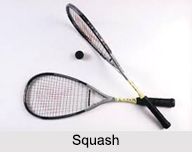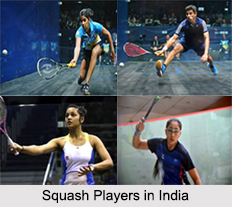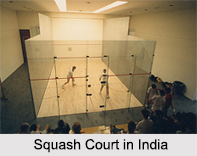 Squash in India is run and managed by several national and state level organizations, which are an integral part of the Management of Indian Squash. The organization has taken several initiatives to promote the sport, conducting various training camps to bring up young and talent players from the grass roots levels.
Squash in India is run and managed by several national and state level organizations, which are an integral part of the Management of Indian Squash. The organization has taken several initiatives to promote the sport, conducting various training camps to bring up young and talent players from the grass roots levels.
History of Squash
Squash is the newest of the racket and ball games that have gained much popularity. The game originated at the Harrow School, England. It is said that in 1850, boys waiting for their turn to play rackets knocked a ball about in a confined space adjoining the rackets court. The area was so small that it was necessary to use a softer and slower ball-one which could be squashed with hand-thus giving the game its name. Initially the game was popular among the rich. The Squash Rackets Association was formed in 1929. Around the Second World War, the game became popular with the British troops. They built numerous courts in India and Egypt. Later it was the Royal Air Force which popularised the game by building courts at all its stations. The International Squash Rackets Federation`s first meeting was held in 1967. The other members who participated in the meeting were England, Pakistan, Australia, South Africa, New Zealand and the United Arab Republic.
Apart from conducting training camps, the Indian Squash associations also organise various Squash tournaments in India. All the training camps and tournaments have played an important role in producing several accomplished squash players in India.
Indian Squash Players
Indian Squash players have distinguished themselves in several national, regional and international tournaments. They have also been honoured by the Government of India, which presented them the prestigious Arjuna Award from time to time. All the Arjuna awardees in Squash are the greatest players of Indian Squash and they have contributed a lot to the development of Indian Squash. Some Squash luminaries include Bhubneshwari Kumari (16 Women`s National championship winner) who was awarded both the Arjuna Award in 1982 and the Padmashri in 2001, Capt. K.S. Jain (Arjuna Award winner and Arjan Singh (Arjuna Award winner). Dipika Pallikal is the topmost Indian squash player as of 2014. She is the first Indian woman to break into the top 10 in the Women`s Squash Association rankings.
Training Camps of Squash
The training camps mainly teach the rules of Squash and terms of Squash and provide training on modern squash techniques. Though this game is a recent addition to the sports culture, but it is now played in over 130 countries.
Equipments of Squash
Some of the equipments of Squash are as follows:
Rackets
The squash racket has the following specifications:
Shape: Circular head of wood strung with gut with a wooden handle (sometimes of metal).
Length: Not more than 27 in.
Internal Stringing Area: Not more than 8 1/2 in long and 71/2 in wide.
Squash Ball
The ball is hollow and squashy in nature having the following specifications:
Diameter: just over 11/2 in (39.5 to 41.5 mm).
Weight: 23.3-24.6 gm.
It is made of rubber or butyl or combination of both.
Dress
Squash dress should be white or light pastel colour. Shoes should have soles which will not produce scratch mark on the surface of the court.




